Disclaimer
The community here at 355nation.net urges you to please use caution and seek professional assistance when performing modifications to your vehicle. Before attempting any modification it is advised that you refer to your Colorado or Canyon service manual or contact a certified mechanic as not all GMT355 trucks are the same. The staff and the associated members are in no way responsible for any damages, injuries or other harm inflicted to your vehicle or yourself which may result in attempting these modifications. The posts and content presented on this site reflect in no way the views of 355nation.net or it’s ownership.
![Image]()
A 355nation How To presented by
jackedupcanyon
Project Name
How-to flush your power steering fluid
Project Description
How-to flush your power steering fluid
Skill Level
Easy
Project Vehicle
Make: GMC
Model: Canyon
Year: 2007
Engine: 3.7L
Power windows: Yes
Sun Roof: Yes
Body Lift: Yes
Tools Needed
Channel locks and/or pliers
3/8" clear tubing - roughly 12" or so
3/8" barbed fitting capped on the end
3/8" clear tubing - roughly 3 – 4 ft or so
3/8" barbed fitting on both ends
Milk jug
Drain pan
Power steering fluid (full system capacity approximately +/- 48 fluid oz or so)
Hydraulic lift
Project Time
1 hour or so
Project Cost
~$30 - $40 total give or take
Project Procedure
Step 1 - Locate the power steering pump and fluid reservoir.
![Image]()
Step 2 - Take your short piece of 3/8" tubing, insert the barbed fitting and cap the end. (Bottom)
![Image]()
Step 3 - Take your long piece of 3/8" tubing and insert the double barbed end fitting at one end. (Top)
![Image]()
Step 4 - Locate the metal supply and rubber return lines on the steering pump reservoir.
![Image]()
Step 5 - With a drain pan under the truck, disconnect the rubber return line and quickly slide the short piece of 3/8" tubing capped on the end over the return connection on the bottom of the pump/reservoir. This section of tubing will fill up with the old steering fluid in the reservoir. If you have had your truck 2 or more years and have never changed your power steering fluid then it will probably look dirty but that is why you are flushing it. Picture below is with the tubing sticking out under the fender wheel well. The fluid color in the bottle was not accurately shown in the picture so I photoshopped the fluid in a syringe for a better representation. Only 2 years on the steering fluid in the truck and as you can see it was almost black.
![Image]()
Step 6 - Quickly slide the long piece of 3/8" tubing with the double barbed fitting and slide it over the other end of the return hose tubing. Put the end of tubing with no fitting into a milk jug or other container to catch the old fluid.
![Image]()
Step 7 - Take the cap off the steering pump reservoir and lift the front of the vehicle up where the tires are off the ground.
![Image]()
Step 8 - Turn the steering wheel a few cycles back and forth to pump the old fluid out of the system. It does not take many turns. Continue to do this till the fluid starts to spit and sputter.
![Image]()
Step 9 – Add new fluid to the reservoir and turn the steering wheel a few cycles back and forth to pump the new fluid thru the system. Continue to do this till you see new fluid starts to come out of the tubing. The fluid will continue to lighten up as you flush the old fluid out. Do this till you are satisfied that old fluid is flushed out enough.
![Image]()
Step 10 - Quickly disconnect the long tubing from the return line, short piece of 3/8" tubing capped on the end and reconnect the existing rubber return line to the bottom of the steering pump reservoir.
![Image]()
Step 11 - Turn the steering wheel a few cycles back and forth to pump the fluid thru the system. Lower the vehicle and check the amount of fluid in the steering pump reservoir. Add as needed.
Step 12 - Again lift the front of the vehicle where the tires are off the ground and turn the steering wheel a few cycles back and forth to pump the fluid thru the system.
Step 13 - Lower the vehicle and re-check the amount of fluid in the steering pump reservoir. Add as needed. Repeat steps 11 and 13 until the fluid in the reservoir is within the acceptable range.
Step 14 - DONE! Drive the vehicle for a day or so and recheck. Add fluid as needed.
The community here at 355nation.net urges you to please use caution and seek professional assistance when performing modifications to your vehicle. Before attempting any modification it is advised that you refer to your Colorado or Canyon service manual or contact a certified mechanic as not all GMT355 trucks are the same. The staff and the associated members are in no way responsible for any damages, injuries or other harm inflicted to your vehicle or yourself which may result in attempting these modifications. The posts and content presented on this site reflect in no way the views of 355nation.net or it’s ownership.

A 355nation How To presented by
jackedupcanyon
Project Name
How-to flush your power steering fluid
Project Description
How-to flush your power steering fluid
Skill Level
Easy
Project Vehicle
Make: GMC
Model: Canyon
Year: 2007
Engine: 3.7L
Power windows: Yes
Sun Roof: Yes
Body Lift: Yes
Tools Needed
Channel locks and/or pliers
3/8" clear tubing - roughly 12" or so
3/8" barbed fitting capped on the end
3/8" clear tubing - roughly 3 – 4 ft or so
3/8" barbed fitting on both ends
Milk jug
Drain pan
Power steering fluid (full system capacity approximately +/- 48 fluid oz or so)
Hydraulic lift
Project Time
1 hour or so
Project Cost
~$30 - $40 total give or take
Project Procedure
Step 1 - Locate the power steering pump and fluid reservoir.
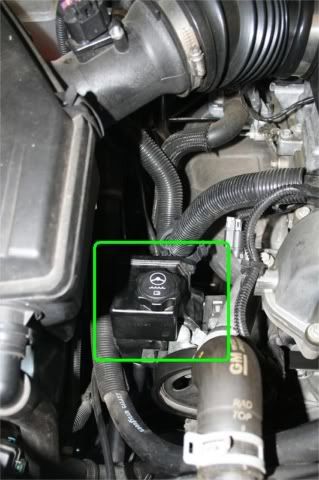
Step 2 - Take your short piece of 3/8" tubing, insert the barbed fitting and cap the end. (Bottom)
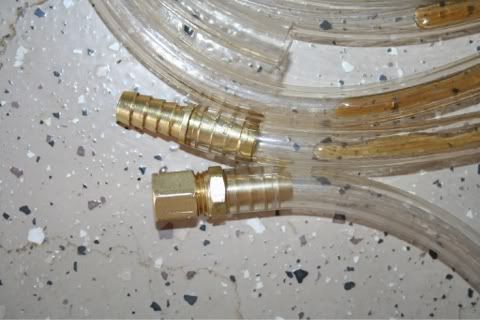
Step 3 - Take your long piece of 3/8" tubing and insert the double barbed end fitting at one end. (Top)

Step 4 - Locate the metal supply and rubber return lines on the steering pump reservoir.
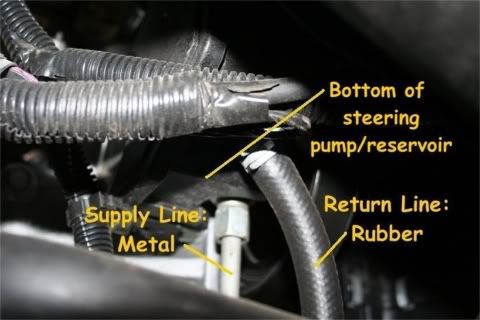
Step 5 - With a drain pan under the truck, disconnect the rubber return line and quickly slide the short piece of 3/8" tubing capped on the end over the return connection on the bottom of the pump/reservoir. This section of tubing will fill up with the old steering fluid in the reservoir. If you have had your truck 2 or more years and have never changed your power steering fluid then it will probably look dirty but that is why you are flushing it. Picture below is with the tubing sticking out under the fender wheel well. The fluid color in the bottle was not accurately shown in the picture so I photoshopped the fluid in a syringe for a better representation. Only 2 years on the steering fluid in the truck and as you can see it was almost black.
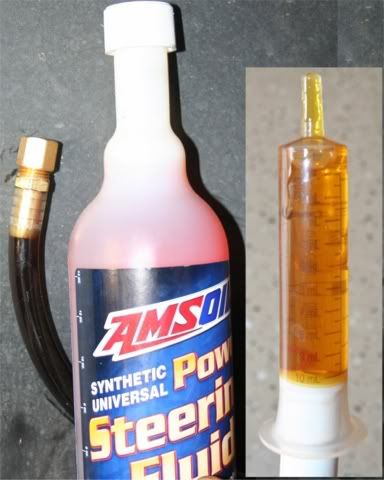
Step 6 - Quickly slide the long piece of 3/8" tubing with the double barbed fitting and slide it over the other end of the return hose tubing. Put the end of tubing with no fitting into a milk jug or other container to catch the old fluid.
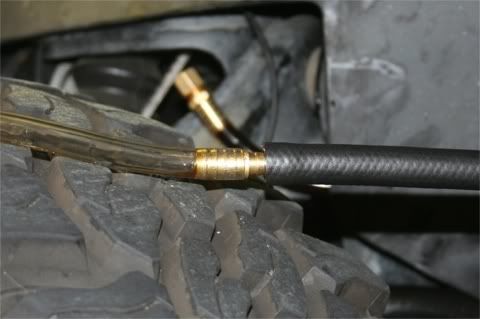
Step 7 - Take the cap off the steering pump reservoir and lift the front of the vehicle up where the tires are off the ground.
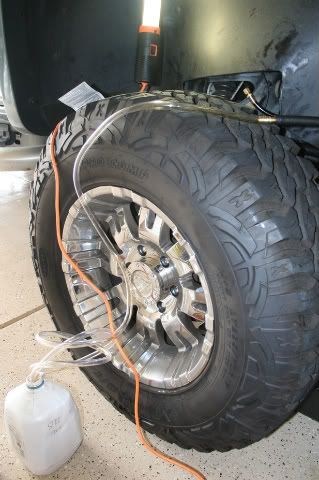
Step 8 - Turn the steering wheel a few cycles back and forth to pump the old fluid out of the system. It does not take many turns. Continue to do this till the fluid starts to spit and sputter.
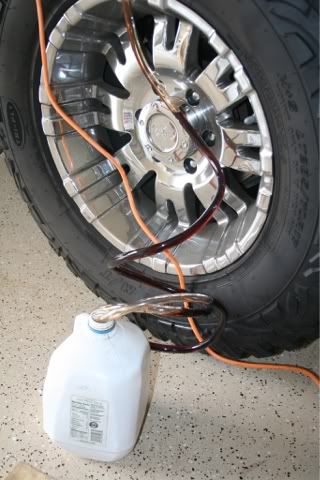
Step 9 – Add new fluid to the reservoir and turn the steering wheel a few cycles back and forth to pump the new fluid thru the system. Continue to do this till you see new fluid starts to come out of the tubing. The fluid will continue to lighten up as you flush the old fluid out. Do this till you are satisfied that old fluid is flushed out enough.
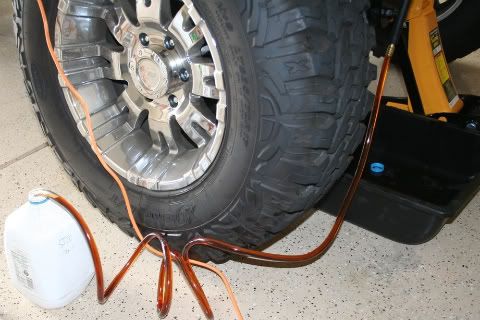
Step 10 - Quickly disconnect the long tubing from the return line, short piece of 3/8" tubing capped on the end and reconnect the existing rubber return line to the bottom of the steering pump reservoir.

Step 11 - Turn the steering wheel a few cycles back and forth to pump the fluid thru the system. Lower the vehicle and check the amount of fluid in the steering pump reservoir. Add as needed.
Step 12 - Again lift the front of the vehicle where the tires are off the ground and turn the steering wheel a few cycles back and forth to pump the fluid thru the system.
Step 13 - Lower the vehicle and re-check the amount of fluid in the steering pump reservoir. Add as needed. Repeat steps 11 and 13 until the fluid in the reservoir is within the acceptable range.
Step 14 - DONE! Drive the vehicle for a day or so and recheck. Add fluid as needed.






